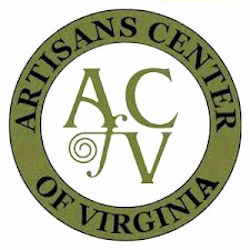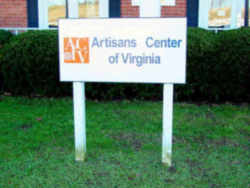
Virginia Symbols
Virginia State Artisans Center
Artisans Center of Virginia

City of Waynesboro, Virginia
Adopted on July 1, 1999
Delegate R. Steven Landes, representing House District 25, has sponsored House Bill 1593 that would designate the Artisans Center of Virginia, located in the City of Waynesboro, as the Official Artisans Center of the Commonwealth. This bill was brought to the Senate by Senator Emmett W. Hanger, Jr., representing Senate District 24, as Senate Bill 1027. The bill was signed by the Governor on March 10, 1999 and became effective on July 1, 1999.
Virginia State Artisans Center: Artisans Center of Virginia

The culture of the Virginia Artisan inspires appreciative audiences with its unique products while expressing a distinctive way of life. It invokes a natural order, firmly woven into the everyday fabric of an artisan's life, embracing familiarities between the acts of creating and living. Once immersed in the culture, whether producing "hand-made"or enjoying the use and aesthetic of artisan produced items, an intimate lifelong relationship of value and appreciation emerges strong and true. Artisan culture links the past, present & future, reconciling "meaning" with "making", as it embodies traditional practices and explores creative innovations and new trends that touch all facets of society.
The History of the Artisans Center of Virginia
In 1987, then Governor Gerald Baliles included the statement "enhancement of the craft industry"in a set of directives to state agencies. To meet this directive various public and private entities worked to bring Virginia's craftspeople together to draft a list of needs and desires for the craft industry. Always at the top of that list was the need for a unified presence for Virginia craft.
In 1997 the Artisans Center of Virginia was incorporated and on June 11, 2000, it was designated to the public as the "official state artisans center." Service to the entire state and its artisan community has been at the forefront of planning and programming. ACV realized that in order to best serve Virginia's artisans it needed to attract the public and provide sustainable economic opportunities to developing craft businesses while working to train tomorrow's craftsmen and keep the culture of handmade quality Virginia craft alive and thriving.
From 2000 - 2009, ACV operated a successful 5,000 square foot sales and exhibitions gallery. During that time outreach objectives included the creation of a statewide Craft Registry, identifying artisans and the venues that serve them and the establishment of the first statewide jury program, utilizing stringent standards to distinguish levels of quality and professionalism among Virginia artisans. This program further identified Master Virginia Artisans who work to perpetuate the business of craft through education and advocacy.
In past years, ACV created a large demonstration and sales gallery at the Virginia State Fair attracting in excess of 250,000 people over an eleven day period, including approximately 30,000 school students who are able to see artisans at work and discuss craft one-on-one with professionals. Additionally, ACV hosted an annual Studio Tour for 15 years in the area surrounding Charlottesville reaching out to over 15,000 visitors each year.
In March of 2009 ACV expanded its statewide scope with a clear objective of creating the collaborations required between state and local governments, planning districts, the small business community, arts organizations, economic development, tourism and artisans to bring the ACV's strategic initiatives to fruition.
The gallery is designed to serve the interests of the people and artisans of Virginia.
ArtisansCenter of Virginia
P.O. Box 166
Greenville, VA 24440
Office: 540-886-1684
Driving directions: Interstate 64 to Exit 94. Turn left onto 340 South, turn at first left Shenandoah Village Drive (approx. ¼ mile), then
first right into Waynesboro Village shopping complex. The Artisans Center is the two-story brick building with pillars directly in front of you as
you come down the main drive.
HOUSE BILL NO. 1593
Offered January 13, 1999
A BILL to amend the Code of Virginia by adding in Chapter 5 of Title 7.1 a section numbered 7.1-40.11, relating to the official state artisans center.
----------
Patrons-- Landes; Senator: Hanger
----------
Referred to Committee on General Laws
----------
Be it enacted by the General Assembly of Virginia:
1. That the Code of Virginia is amended by adding in Chapter 5 of Title 7.1 a section numbered 7.1-40.11 as follows:
§ 7.1-40.11. Official artisans center.
The "Artisans Center of Virginia," located in the City of Waynesboro, is hereby designated the official artisans center of the Commonwealth.
SENATE BILL NO. 1027
Offered January 19, 1999
A BILL to amend the Code of Virginia by adding in Chapter 5 of Title 7.1 a section numbered 7.1-40.11, relating to the official artisan center of Virginia.
----------
Patrons-- Hanger; Delegate: Landes
----------
Referred to Committee on General Laws
----------
Be it enacted by the General Assembly of Virginia:
1. That the Code of Virginia is amended by adding in Chapter 5 of Title 7.1 a section numbered 7.1-40.11 as follows:
§ 7.1-40.11. Official artisan center.
The "Virginia Artisan Center," to be located in the City of Waynesboro, is hereby designated the official artisan center of the Commonwealth.
Virginia Law
The law designating the "Virginia Artisans Center," located in the City of Waynesboro as the official Virginia state artisans center is found in the Code of Virginia, Title 1, Chapter 5, Section 1-510. Virginia symbols were re-organized under one section of the Code of Virginia in 2005.
Title 1 - GENERAL PROVISIONS.
Chapter 5 - Emblems
§ 1-510. Official emblems and designations.
The following are hereby designated official emblems and designations of the Commonwealth:
Artisan Center - "Virginia Artisans Center," located in the City of Waynesboro.
Bat - Virginia Big-eared bat (Corynorhinos townsendii virginianus).
Beverage - Milk.
Blue Ridge Folklore State Center - Blue Ridge Institute located in the village of Ferrum.
Boat - "Chesapeake Bay Deadrise."
Covered Bridge Capital of the Commonwealth - Patrick County.
Covered Bridge Festival - Virginia Covered Bridge Festival held in Patrick County.
Dog - American Foxhound.
Emergency medical services museum - "To The Rescue," located in the City of Roanoke.
Fish - Brook Trout.
Fleet - Replicas of the three ships, Susan Constant, Godspeed, and Discovery, which comprised the Commonwealth's founding fleet that brought
the first permanent English settlers to Jamestown in 1607, and which are exhibited at the Jamestown Settlement in Williamsburg.
Flower - American Dogwood ( Cornus florida).
Folk dance - Square dancing, the American folk dance that traces its ancestry to the English Country Dance and the French Ballroom Dance, and is called,
cued, or prompted to the dancers, and includes squares, rounds, clogging, contra, line, the Virginia Reel, and heritage dances.
Fossil - Chesapecten jeffersonius.
Gold mining interpretive center - Monroe Park, located in the County of Fauquier.
Insect - Tiger Swallowtail Butterfly (Papilio glaucus Linne).
Motor sports museum - "Wood Brothers Racing Museum and Virginia Motor Sports Hall of Fame," located in Patrick County.
Outdoor drama - "The Trail of the Lonesome Pine Outdoor Drama," adapted for the stage by Clara Lou Kelly and performed in the Town of Big
Stone Gap.
Outdoor drama, historical - "The Long Way Home" based on the life of Mary Draper Ingles, adapted for the stage by Earl Hobson Smith, and
performed in the City of Radford.
Shell - Oyster shell (Crassostrea virginica).
Song emeritus - "Carry Me Back to Old Virginia," by James A. Bland, as set out in the House Joint Resolution 10, adopted by the General Assembly
of Virginia at the Session of 1940.
Sports hall of fame - "Virginia Sports Hall of Fame," located in the City of Portsmouth.
War memorial museum - "Virginia War Museum," (formerly known as the War Memorial Museum of Virginia), located in the City of Newport News.
(Code 1950, § 7-35, 7-36, 7-37; 1966, cc. 102, 547, § 7.1-37, 7.1-38, 7.1-39; 1974, c. 24, § 7.1-40; 1982, c. 191, § 7.1-40.1;
1986, c. 138, § 7.1-40.2; 1988, c. 317, § 7.1-40.3; 1991, cc. 71, 575, § 7.1-40.4, 7.1-40.5; 1993, cc. 251, 509, § 7.1-40.6; 1994,
cc. 33, 134, 220, 464, § 7.1-40.2:1, 7.1-40.8; 1995, cc. 12, 180, § 7.1-40.2:2; 1996, c. 52, § 7.1-40.9; 1997, cc. 66, 576, § 7.1-40.10;
1999, cc. 69, 336, § 7.1-40.11; 2001, cc. 97, 134, § 7.1-40.12; 2001, c. 228, § 7.1-40.13; 2005, cc. 557, 839; 2006, c. 128; 2007, cc.
391, 685; 2008, c. 262.)







